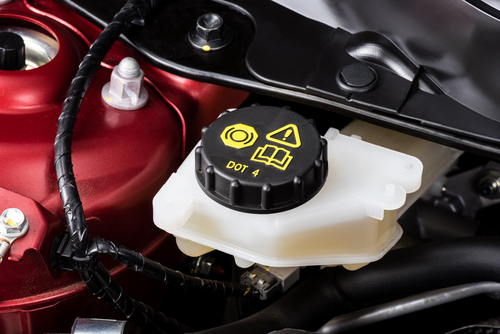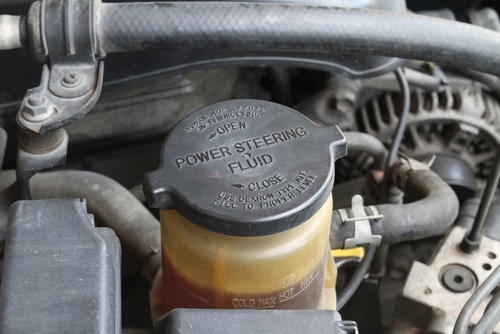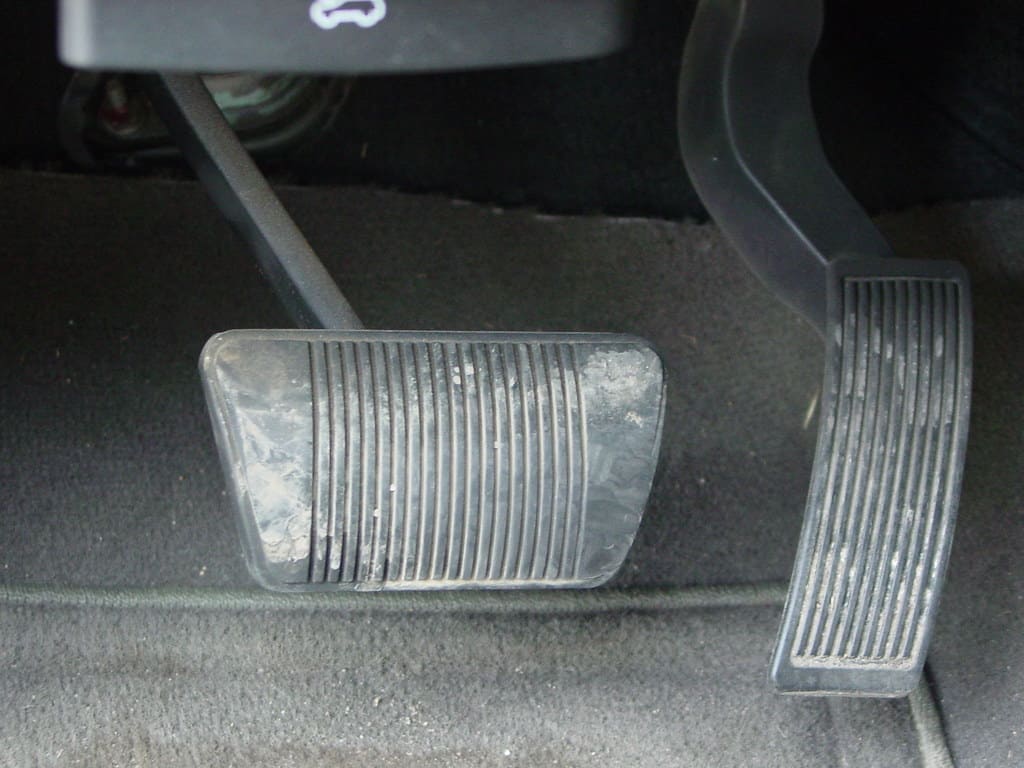Ever found yourself in a bind, wondering if you can substitute brake fluid for power steering fluid? It’s a common question that pops up when you’re faced with a power steering issue and only have brake fluid on hand.
Well, buckle up, because we’re about to steer you in the right direction!

Brake fluid and power steering fluid are not interchangeable, and using one in place of the other can lead to serious damage to your vehicle’s systems.
While both fluids play crucial roles in keeping your car running smoothly, they have different compositions and properties that make them uniquely suited for their specific tasks.
Don’t worry if you’ve been tempted to make this swap in a pinch. We’ve all been there, trying to MacGyver our way out of a sticky situation.
But when it comes to your car’s vital fluids, it’s best to stick to what the manufacturer recommends. Trust me, your wallet (and your mechanic) will thank you later!
Key Takeaways
- Brake fluid and power steering fluid have different compositions and cannot be used interchangeably.
- Using the wrong fluid can cause severe damage to your vehicle’s systems.
- Regular maintenance and using the correct fluids are crucial for optimal vehicle performance and safety.
The Role of Fluids in Vehicle Operations
Fluids are the lifeblood of your car, keeping everything running smoothly. Without them, you’d be left with a very expensive paperweight in your driveway.
Understanding Power Steering Fluid
Power steering fluid is like the magic potion that makes your steering wheel obey your every command. It’s a hydraulic fluid that helps you turn those wheels without breaking a sweat.
This liquid gold flows through your power steering system, reducing the effort needed to steer. It’s like having a tiny Superman in your car, ready to assist you at every turn.
Power steering fluid also acts as a lubricant, keeping the system’s components happy and preventing wear and tear.
It’s designed to withstand high temperatures and pressures, much like your patience during rush hour traffic.
Remember, your power steering fluid isn’t immortal. Check it regularly and top it up when needed. Your arms will thank you later!
Brake Fluid Basics
Brake fluid is the unsung hero of your vehicle’s safety system. It’s the reason you don’t plow through stop signs like a runaway train.
This hydraulic fluid transfers the force from your foot on the pedal to the brake system, bringing your car to a stop. It’s like a liquid messenger, carrying your “whoa, slow down!” command to the wheels.
Brake fluid is hygroscopic, which means it absorbs moisture faster than a sponge at a water park. This can lead to reduced effectiveness and even corrosion in your brake system.
Unlike power steering fluid, brake fluid comes in different grades (DOT 3, DOT 4, etc.).
Using the wrong type is like putting diesel in a petrol car – not a good idea!
Regular brake fluid checks are crucial. If it looks darker than your morning coffee, it’s time for a change. Your life might depend on it!
Why Power Steering and Brake Fluids Aren’t Interchangeable

You might think all automotive fluids are the same, but that’s like saying motor oil and maple syrup are interchangeable on your pancakes. Power steering and brake fluids have distinct roles, and mixing them up is a recipe for disaster.
Differences in Chemical Composition and Purpose
Power steering fluid is like the smooth-talking lubricant of your car’s steering system. It’s designed to keep your steering components happy and protected.
This hydraulic fluid has a specific viscosity to ensure your steering feels as smooth as butter on a hot day.
Brake fluid, on the other hand, is the unsung hero of your stopping power. It’s got a much lower viscosity and is hygroscopic, which means it loves to absorb moisture like your Uncle Bob at an open bar. This property is crucial for maintaining consistent braking performance.
The chemical makeup of these fluids is as different as chalk and cheese. Power steering fluid is often petroleum-based, while brake fluid is typically glycol-based.
Mixing these would be like inviting a vegetarian to a steakhouse – it just won’t work out well.
The Impact of Using the Wrong Fluid
Now, you might be thinking, “What’s the worst that could happen?”
Well, buckle up, because it’s not a pretty picture. Using brake fluid in your power steering system is like putting a piranha in your goldfish bowl.
Brake fluid can cause the seals in your power steering system to swell and deteriorate faster than your New Year’s resolutions. This can lead to leaks, reduced steering ability, and a repair bill that’ll make your wallet cry.
On the flip side, power steering fluid in your brake system is equally disastrous.
It can cause your brake seals to fail, leading to a loss of braking power. Suddenly, stopping at that red light becomes an exciting game of chance.
Remember, your car’s fluids are like a delicate ecosystem. Disrupting it with the wrong fluid can lead to damage, decreased performance, and safety hazards that’ll have you wishing you’d just stuck to the owner’s manual.
Consequences for Steering and Braking Systems

Mixing up brake fluid and power steering fluid can wreak havoc on your vehicle’s vital systems. Let’s take a look at how this automotive faux pas can turn your smooth ride into a mechanical nightmare.
Effects on the Power Steering Pump and Components
Your power steering pump isn’t designed to handle brake fluid’s unique properties.
When you introduce this foreign substance, it’s like forcing your pump to digest a greasy cheeseburger instead of its usual balanced diet.
The higher viscosity of brake fluid can cause the pump to work overtime, leading to premature wear and tear.
The seals and hoses in your power steering system might start to swell or deteriorate.
Imagine your car’s innards turning into a leaky sieve – not a pretty picture, right?
You might notice a funky smell coming from the steering area, which is your car’s way of saying, “Hey, something’s not right in here!”
If left unchecked, this mishap can lead to permanent damage to your power steering system.
Your smooth turns could become a workout session, and that’s not the kind of exercise you signed up for when you bought your car.
Risks to Brake Lines and the Master Cylinder

Now, let’s flip the script. What if power steering fluid ends up in your brake system?
Well, your master cylinder might just throw in the towel. This crucial component relies on specific fluid properties to function correctly.
Power steering fluid can cause the rubber seals in your brake system to swell and degrade.
It’s like trying to fit into your high school jeans – something’s gotta give, and it won’t be pretty.
Your brake pedal might feel spongy or go straight to the floor, which is about as reassuring as a parachute made of tissue paper.
The hydraulic system in your brakes could suffer serious damage.
Remember, brake fluid has a higher boiling point for a reason.
Using the wrong fluid could lead to brake failure when you least expect it.
And trust me, that’s not the kind of surprise anyone wants while cruising down the highway.
Correct Fluids for Optimal Performance
Keeping your car’s fluids in check is like giving it a daily vitamin boost. Let’s dive into the world of steering and braking fluids – trust me, it’s more exciting than it sounds!
Selecting the Right Power Steering Fluid
You know that smooth feeling when you turn your steering wheel? That’s your power steering fluid working its magic.
Most cars need specific synthetic power steering fluid, but some older models might use automatic transmission fluid (ATF).
Check your owner’s manual – it’s like a cheat sheet for your car.
Using the wrong fluid is like putting diesel in a gas engine – not pretty!
Some vehicles even use different viscosities, so don’t just grab any bottle off the shelf.
If you’re in a pinch, ATF might work temporarily in some power steering systems. But it’s not a long-term solution, folks. Get the right stuff ASAP to keep your steering silky smooth.
Choosing Appropriate Brake Fluid
Now, let’s talk about the fluid that literally saves your bacon – brake fluid. This stuff is no joke, and using the wrong type can spell disaster.
Brake fluids come in different grades: DOT 3, DOT 4, and DOT 5.1. Each has its own boiling point and performance characteristics.
Most modern cars use DOT 4, but always double-check your manual. Mixing different types is a big no-no – it’s like trying to blend oil and water.
Remember, brake fluid is hygroscopic – it loves to absorb moisture from the air.
That’s why you should always use a fresh, unopened bottle when topping up. Old fluid can compromise your braking system, and nobody wants that surprise on the road!
Maintenance Tips for Power Steering and Brake Systems
Keeping your car’s power steering and brake systems in tip-top shape is crucial for a smooth, safe ride. Let’s dive into some key maintenance tips that’ll keep you cruising without any steering or stopping hiccups.
Regular Checks and Fluid Replacement
First things first, pop the hood and take a peek at your power steering fluid reservoir. It’s like checking the oil, but way less messy.
You want that fluid level to be just right – not too high, not too low. Think Goldilocks, but for your car.
Every 30,000 miles or so, treat your steering system to a fresh batch of power steering fluid. It’s like a spa day for your car’s hydraulic pressure system.
While you’re at it, don’t forget about your brake fluid.
These systems might not share fluids, but they do share the need for regular TLC.
Here’s a quick checklist for you:
- Check power steering fluid monthly
- Replace power steering fluid every 30,000 miles
- Inspect brake fluid every oil change
- Replace brake fluid every 2 years or 24,000 miles
Detecting and Addressing Leaks
Got a car that’s leaving little puddles wherever it goes? That’s not normal, folks.
Your steering and brake systems should be as leak-free as a submarine. Keep an eye out for any suspicious spots on your driveway or garage floor.
If you notice your power steering fluid levels dropping faster than your gas tank on a road trip, you might have a leak. Same goes for brake fluid.
A spongy brake pedal could mean your brake lines are losing their juice.
Don’t ignore these signs:
- Puddles under your car
- Dropping fluid levels
- Steering wheel resistance
- Spongy brake pedal
If you spot any of these, get your ride to a mechanic pronto.
They’ll have the tools and know-how to patch things up before you end up with a steering wheel that’s harder to turn than a stubborn jar lid or brakes that are about as effective as shouting “STOP!” at your car.
Frequently Asked Questions
Mixing up automotive fluids can lead to serious consequences. Let’s address some common questions about brake fluid and power steering fluid to help you avoid costly mistakes.
What happens if you mistakenly add brake fluid to your power steering system?
You’re in for a world of hurt, my friend. Adding brake fluid to your power steering system can cause irreparable damage.
The seals and hoses in your power steering aren’t designed to handle brake fluid’s corrosive nature. You’ll likely end up with leaks, system failures, and a hefty repair bill.
Is there any situation where brake fluid can serve as a suitable substitute for power steering fluid?
Not unless you want to turn your smooth steering into a wrestling match with your wheel. Brake fluid and power steering fluid are about as compatible as oil and water.
Using brake fluid in your power steering system is a surefire way to damage components and compromise your vehicle’s safety.
Are there any vehicles that actually require DOT 3 or DOT 4 fluids for their power steering?
Nope, not a single one. DOT 3 and DOT 4 are strictly for brake systems.
If you come across a vehicle that claims to need these for power steering, someone’s pulling your leg or confusing their fluids.
If I’m in a pinch, what fluids can I use as an emergency replacement for power steering fluid?
In a real pinch, you might get away with using automatic transmission fluid (ATF) temporarily. But remember, it’s like using duct tape to fix a leaky pipe – it’ll work for a bit, but you’re asking for trouble if you don’t replace it with the proper fluid ASAP.
Can transmission fluid double as power steering fluid, or are they two completely different beasts?
They’re cousins, not twins. Some older vehicles actually use ATF in their power steering systems.
However, modern cars typically require specific power steering fluids. Check your owner’s manual before you start mixing and matching.
In terms of chemical properties, how does brake fluid differ from power steering fluid?
Brake fluid is hygroscopic, meaning it absorbs moisture from the air.
Power steering fluid, on the other hand, is designed to resist moisture.
This fundamental difference is why they don’t play well together in each other’s systems.
